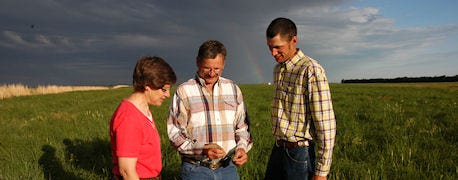September 14, 2012

Get an inside look at an award winning ranch in eastern South Dakota this week.
There will be a tour of the Jim and Karen Kopriva ranch near Raymond, S.D., on Thursday, Sept. 20. The Koprivas won the Leopold Conservation Award for South Dakota this year.
The agenda for the tour is as follows:
9:30 am Registration
10:00 am Welcome and presentation of award by the Sand County Foundation
10:30 am Video
10:45 am Speaker: Rick Smith, Lake Poinsett Watershed Coordinator, "Water -- Are we Losing Control?
11:30am Lunch. Smoked roast beef sandwiches from Dakota Butcher, Clark, S.D., and SDSU Ice Cream. Lunch is free.

Karen, Jim and their son Lee inspect switchgrass growing in one of the pastures they converted from corn and soybean to grass and beef production. They are hosting a tour of their ranch this week.
12:30 am Rainfall simulator demonstration
1:15 pm Ranch tour
4:00 pm Tour concludes
To get to the ranch from Highway 212, turn north at the Raymond turnoff, go 3 miles north to On Hwy 212, turn north at the Raymond turnoff, go north for 3 miles to 169th Street, turn east onto 169th Street and go east 1 3/4 miles. The ranch entrance is on the south side of the road.
Jim and Karen and their son Lee run about 300 head of commercial and registered Angus cows on 2,000 owned and leased acres – of which 1,200 were at one time cropland. Now – 20 years after they established their ranch – just 130 acres are no-tilled and cropped with a spring wheat-winter wheat-soybean rotation. The remaining acres are native rangeland, seeded pastures and hayland, including 500 acres of alfalfa for hay that is sold to the dairy and horse markets. Lee is also establishing his own operation. He runs cattle with his parents and has 600 acres of pasture about 18 miles from the home operation.
"We used to raise crops with conventional tillage, but it seemed there wasn't much profit left. Now, we're focused on bringing most of our land back full circle to native grasses and pastures for grazing," he says.
In 1984, Jim had heard a presentation given by holistic manager Allan Savory. Jim recalls, "He talked about how America is overgrazed but under-stocked. I could see that his grazing concepts worked. That has stuck with me."
More than 25 years later the Kopriva's are using many of Savory's rotational grazing concepts in their own operation and are passing those ideals onto their son as he gets his start in the beef industry as well.
"You can make money with cows," Jim says, "if you can learn to manage your grass. As you improve your grass, you can increase your stocking rate. It's a win-win."
Jim says that rotational grazing has allowed them to increase their pasture capacity by 50%.
As they moved away from grain farming, the Koprivas sold their farming equipment – and now only have equipment for putting up hay and feeding the cattle in the winter months. On the 130 acres of cropland that they lease, they hire no-till planting and custom harvesting. When reseeding hayland to alfalfa, they also hire it to be no-till planted.
Improvements to the Kopriva ranch have included seeding native and tame grass, using prescribed burning on native grass for control of invasive species, cross-fencing, developing water sources and creating a rotational grazing system. In the fall, the Koprivas put their cows on cover crops or crop residue – often corn stalks that they rent from neighbors – to take grazing pressure off their pastures and let forages rest and regrow for the following year. Jim says by getting the grazing pressure off the pasture allows the grass to build up root reserves and seems to have a similar effect that might be seen from fertilizer.
When we see a $20-$30 per acre benefit to the grass, it makes stringing up a few miles of hot wire well worth the effort, and the landowners appreciate the nutrients from manure on their fields as well."
The cost of renting corn stalks is minimal because they typically do a trade agreement with their neighbors and help with the grain harvest.
Jim still sees lots of conservation opportunities that he and Lee can implement together.
"We still have fences to improve and water developments. I'd like to improve our grass stands even more, and utilize the prescribed burning more."
But most importantly, Jim and Karen say they intend to focus on developing a "habitat" for their son Lee to expand and grow his cattle herd without accumulating too much debt. "We want to focus on a sustainable operation," Jim says.
Kindra Gordon, a Whitewood, S.D., freelance writer, contributed to this article..
You May Also Like




